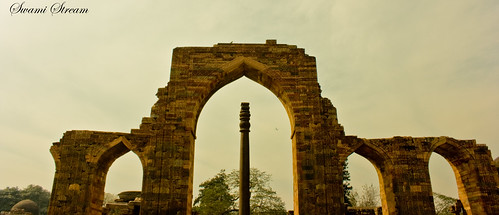The iron pillar of Delhi, India is a 7 meter (22 feet) high pillar next to the Qutub Minar. The pillar was apparently erected at the time of Chandragupta II and is a curiosity because of the composition of the metals used in its construction.
The pillar—almost seven meters (22 feet) high and weighing more than six tons—was allegedly erected at the time of Chandragupta II Vikramaditya (375–413), though other authorities give dates as early as 912 BCE. It is the only remaining piece of a Hindu and Jain temple complex which stood there before being destroyed by Qutb-ud-din Aybak who built around it when he constructed the Qutub Minar and Quwwat-ul-Islam mosque.
The pillar is 98% wrought iron of pure quality, and is a testament to the high level of skill achieved by ancient Indian ironsmiths. It has attracted the attention of both archaeologists and metallurgists, as it has withstood corrosion for 1600 years, despite harsh weather
The inscription reads (in the translation given in the tablets erected by Pandit Banke Rai in 1903):
He, on whose arm fame was inscribed by the sword, when, in battle in the Vanga countries (Bângal), he kneaded (and turned) back with (his) breast the enemies who, uniting together, came against (him);-he, by whom, having crossed in warfare the seven mouths of the (river) Sindhu, the Vâhlikas were conquered;-he, by the breezes of whose prowess the southern ocean is even still perfumed;- (Line 3.)-He, the remnant of the great zeal of whose energy, which utterly destroyed (his) enemies, like (the remnant of the great glowing heat) of a burned-out fire in a great forest, even now leaves not the earth; though he, the king, as if wearied, has quit this earth, and has gone to the other world, moving in (bodily) from to the land (of paradise) won by (the merit of his) actions, (but) remaining on (this) earth by (the memory of his) fame;- (L. 5.)-By him, the king,-who attained sole supreme sovereignty in the world, acquired by his own arm and (enjoyed) for a very long time; (and) who, having the name of Chandra, carried a beauty of countenance like (the beauty of) the full-moon,-having in faith fixed his mind upon (the god) Vishnu, this lofty standard of the divine Vishnu was set up on the hill (called) Vishnupada.
More at en.wikipedia.org/wiki/Iron_pillar_of_Delhi
Lighthouse in Pondycherry
11 years ago


0 comments:
Post a Comment